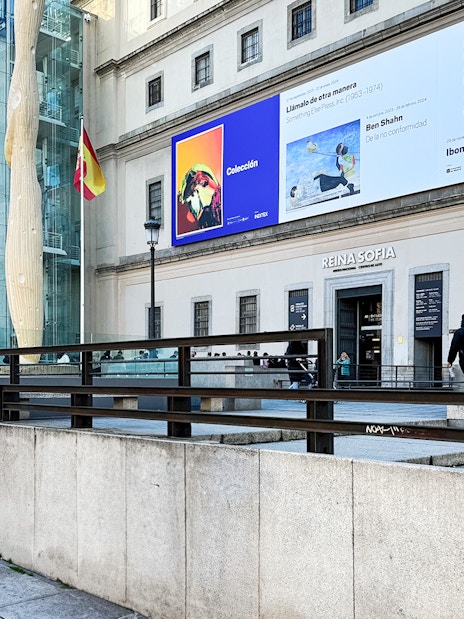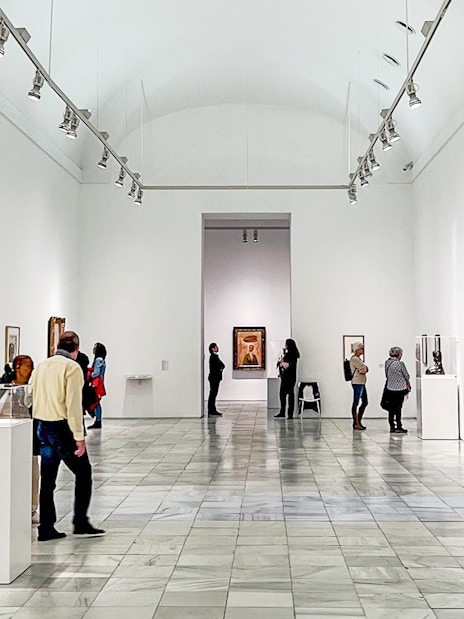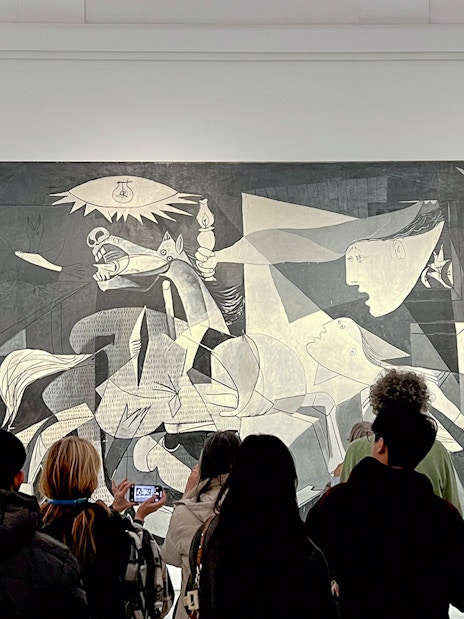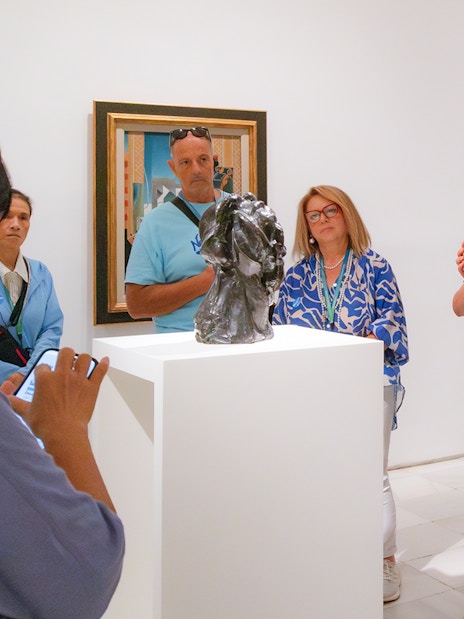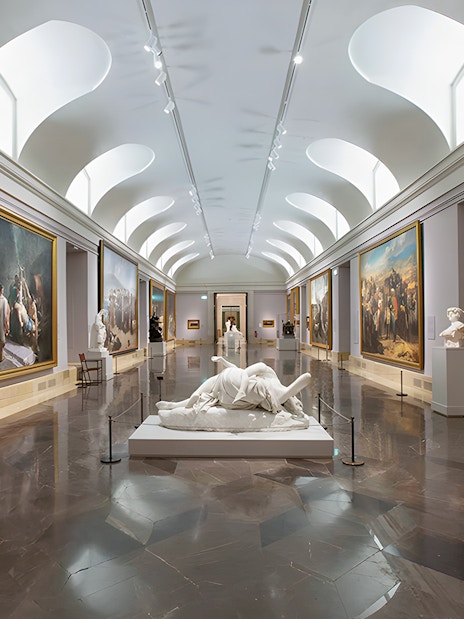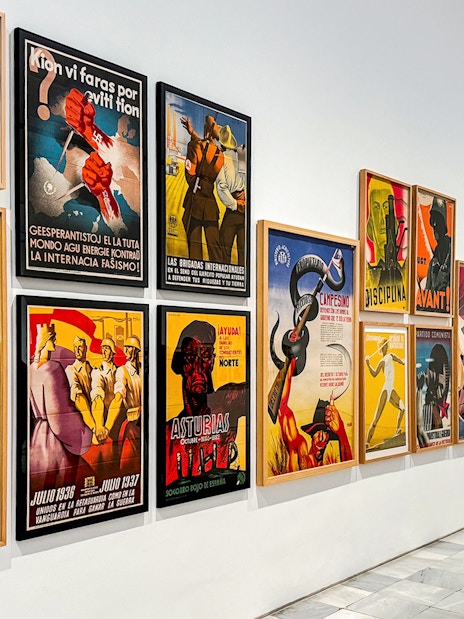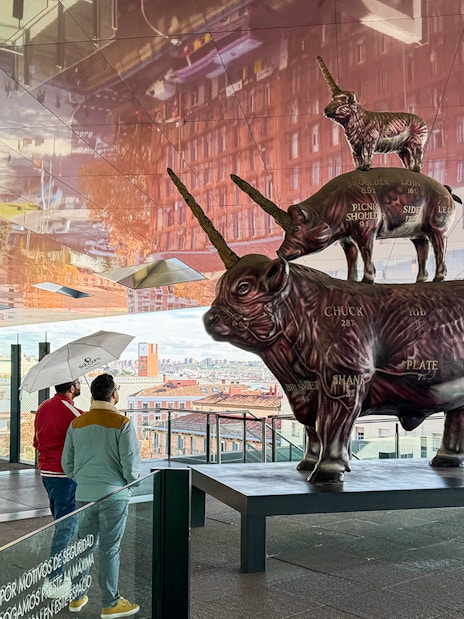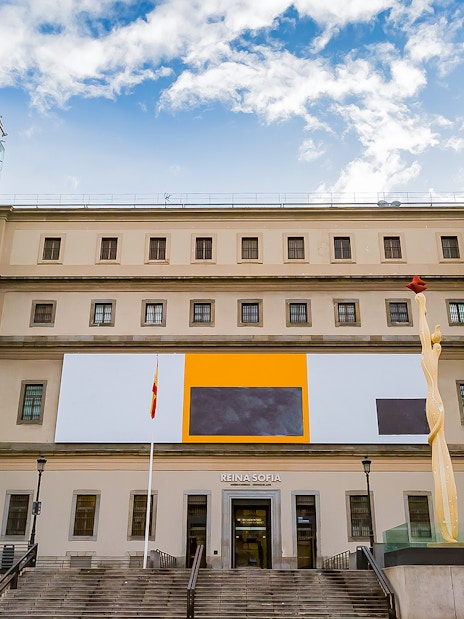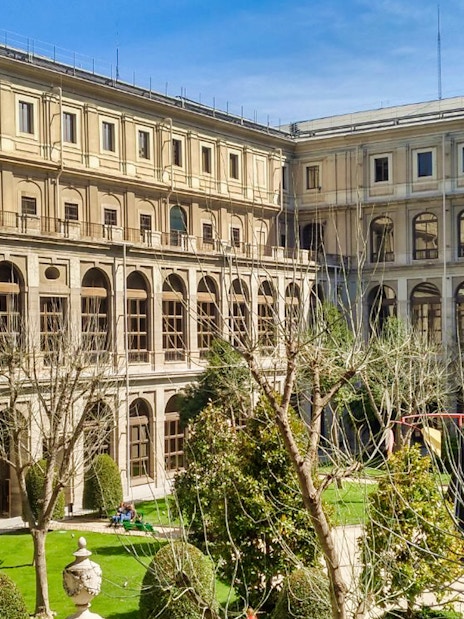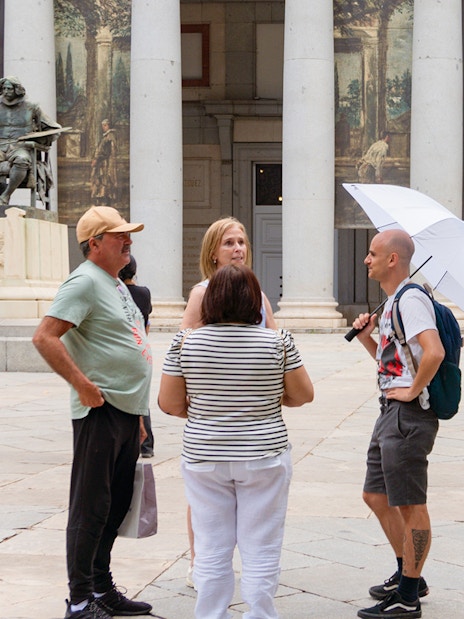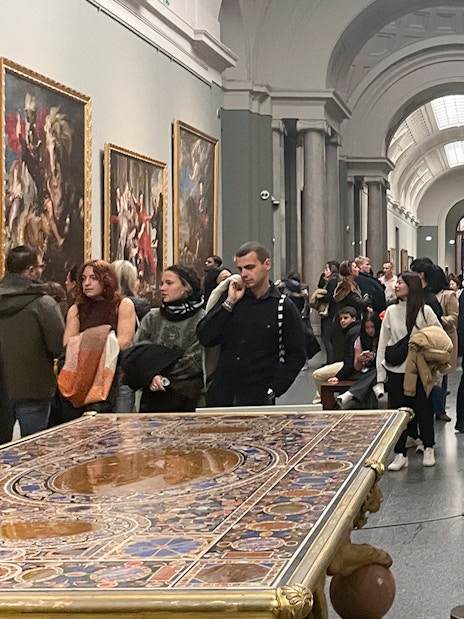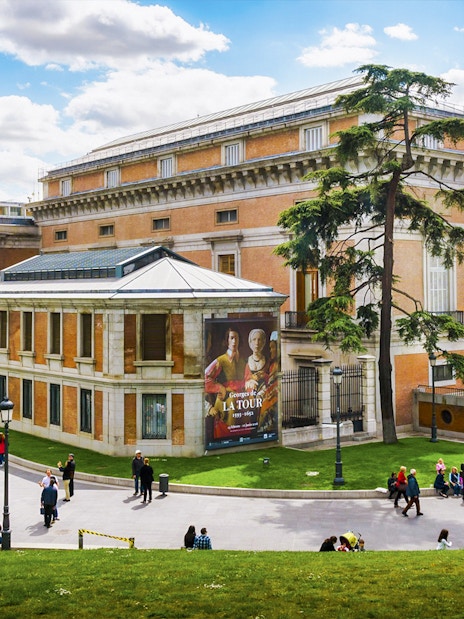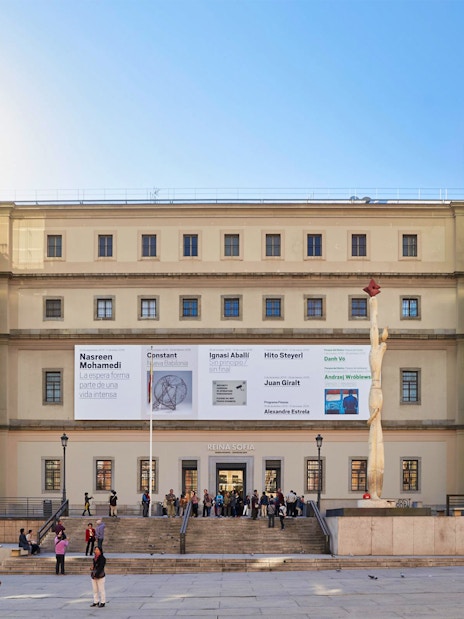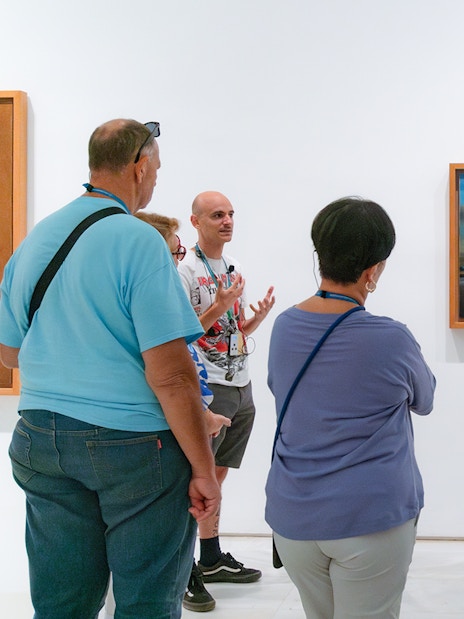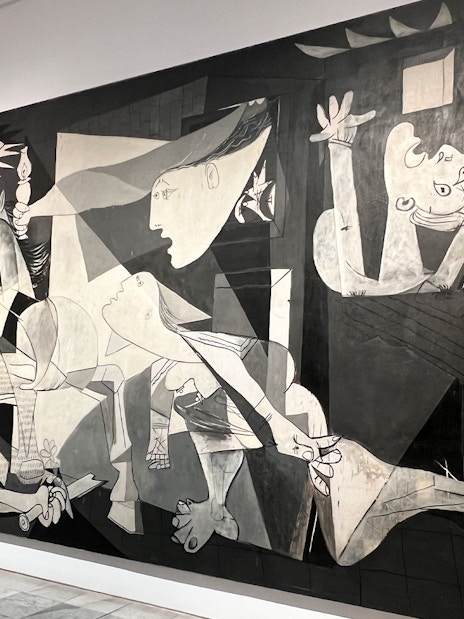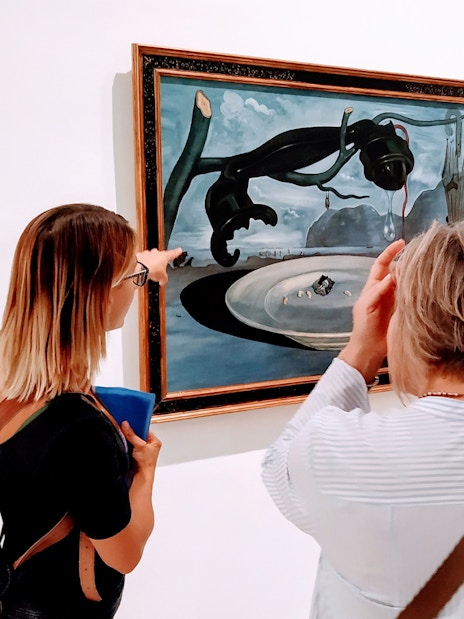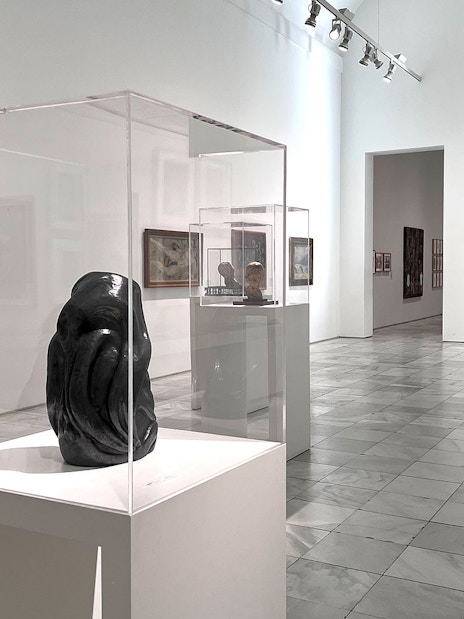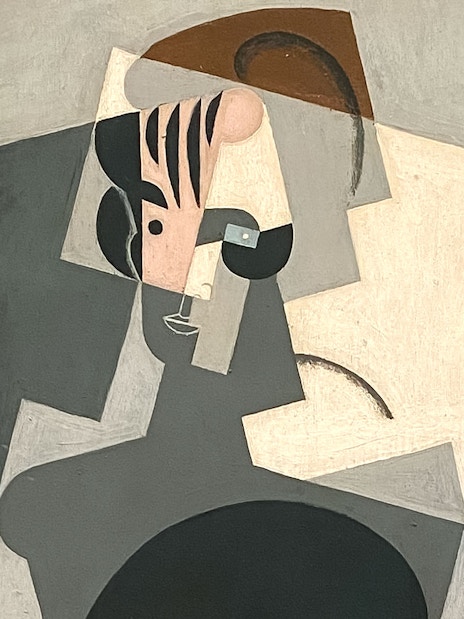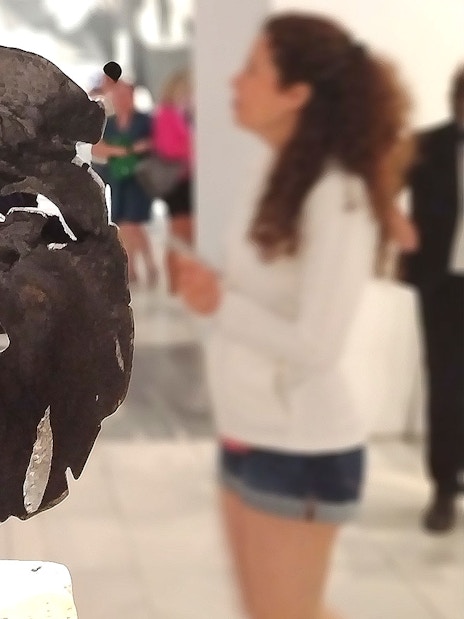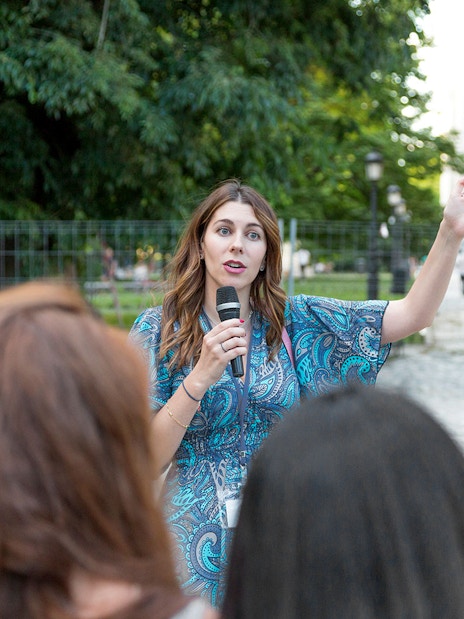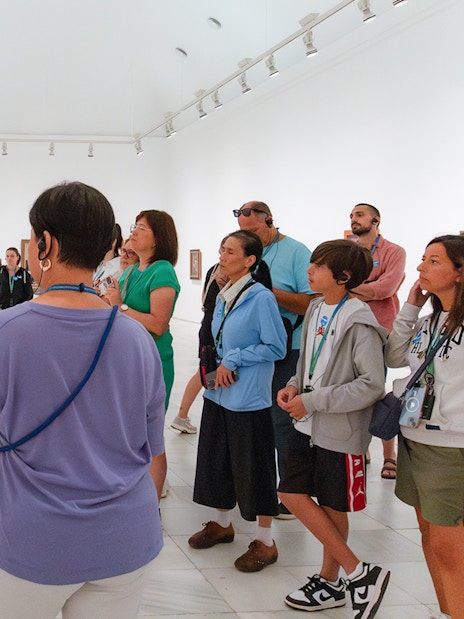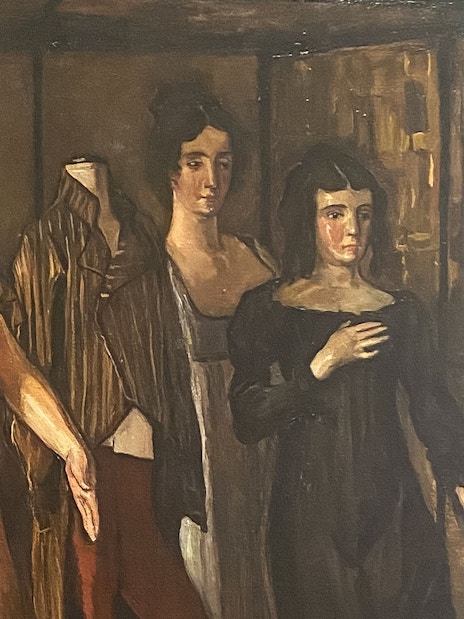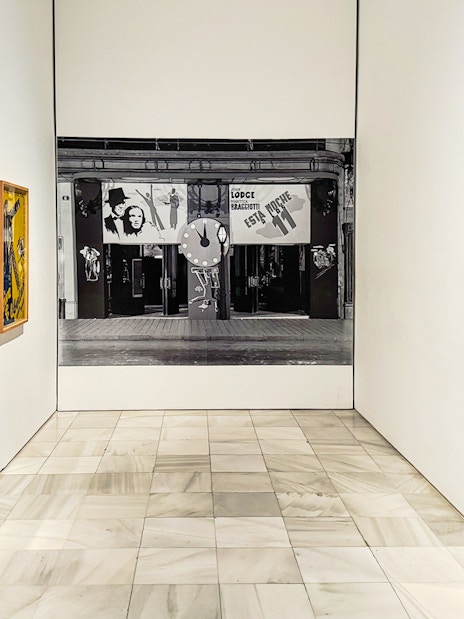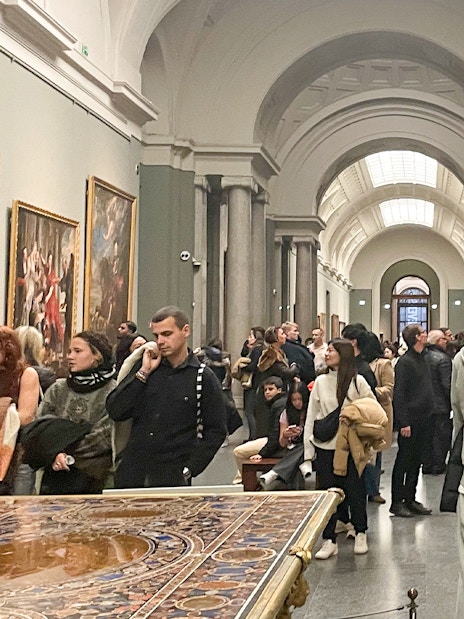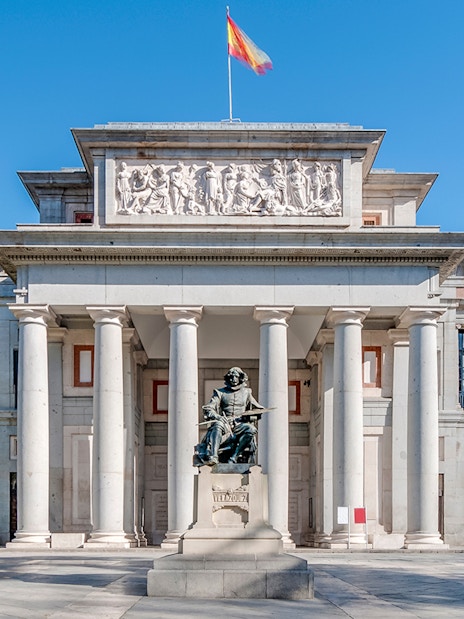Created in 1937 during the Spanish Civil War it stands as a powerful anti-war symbol. Depicting the horrors of the bombing of Guernica, the mural's distorted figures and haunting imagery convey the visceral impact of conflict. This universal masterpiece, housed in the Museo Reina Sofia in Madrid, transcends its historical context, serving as a timeless testament to the devastating consequences of war.
- Royal Palace Of Madrid
- Madrid Prado Museum
- Madrid Flamenco Show Tickets
- Parque Warner Madrid
- Santiago Bernabeu Tours
- Madrid To Toledo Tours
- Thyssen-Bornemisza Museum
- Parque De Atracciones Madrid
- Liria Palace
- Wax Museum Madrid
- Cívitas Metropolitano Stadium Tours
- Museum of Illusions Madrid
- El Escorial Madrid
- Royal Palace Of Aranjuez
- Royal Palace of La Granja of San Ildefonso
- Atlantis Aquarium Madrid
- Ikono
Reina Sofia Museum tickets and tours
Headout is an authorized and trusted partner of the venue, offering curated experiences to enjoy this attraction. This is not the venue's website.
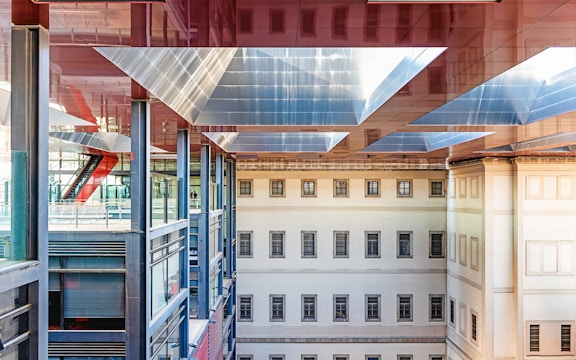
- With tickets to the Reina Sofia Museum, explore the greatest collections of 20th-century Spanish artists, Picasso, Dalí, and Miró!
- Uncover everything from abstract art and cubism to surrealism and modernism as you waltz around permanent and temporary artworks.
- Let thought-provoking exhibitions like Apparatus 92 and Avant-garde Territories reshape your understanding of colonialism and modernism.
- Add art history to your cart with an official audio guide. Decipher the horrors of war in Picasso's work or the power of a muse in Dalí's life.
- Avid art aficionados can upgrade to the Paseo del Arte Pass to access all 3 must-see museums of Madrid – Prado, Reina Sofia, and Thyssen-Bornemisza.
- With tickets to the Reina Sofia Museum, explore the greatest collections of 20th-century Spanish artists, Picasso, Dalí, and Miró!
- Uncover everything from abstract art and cubism to surrealism and modernism as you waltz around permanent and temporary artworks.
- Let thought-provoking exhibitions like Apparatus 92 and Avant-garde Territories reshape your understanding of colonialism and modernism.
- Add art history to your cart with an official audio guide. Decipher the horrors of war in Picasso's work or the power of a muse in Dalí's life.
- Avid art aficionados can upgrade to the Paseo del Arte Pass to access all 3 must-see museums of Madrid – Prado, Reina Sofia, and Thyssen-Bornemisza.
Inclusions
- Entry to Reina Sofia Museum
- Official audio guide in Spanish, English, French, German, Portuguese, Italian, Russian, Korean & Chinese (as per option selected)
- Entry to Prado & Thyssen-Bornemisza Museums with the Paseo del Arte Pass (as per option selected)
Exclusions
- Guided tour
- Tip: Begin your visit with Picasso's masterpiece, Guernica. It's an iconic and powerful plea for pacifism and sets the tone for your museum experience.
- This venue is wheelchair and pram/stroller accessible.
- Flash photography, tripods, and selfie sticks are not allowed in the museum. No photos or videos are allowed in area 206 (Guernica).
- Large bags or luggage measuring more than 30 x 30cm are not allowed in the museum.
- Guests entering with small backpacks must wear them in the front to avoid disturbing other visitors and to ensure they do not brush against the artworks.
- Visitors under the age of 14 must be accompanied by an adult. Anyone between the age of 14 and 18 who wishes to visit the museum without an adult must show their national ID document.
- There is free entry for guests with a valid ID under the age of 18 years, over the age of 65 years, and for students under 25 years.
- Entry is free for guests from certain categories, full list here
- These tickets can’t be cancelled. However, they are valid for an extended period of time.
- These tickets are valid for an extended duration. The exact details will be present on the ticket.
- Thinking of the best way to see 2 of Madrid’s national museums, Prado and Reina Sofia? How about fast-track access guided by art history experts.
- At Prado, learn to spot recurring motifs like Saturn Devouring His Son in Rubens's 17th-century work and Goya's 19th-century version.
- Compare Santos' fluid surrealism in The Gathering with Solana's rigid expressionism in The Gathering at the Café de Pombo at Reina Sofia.
- Dive into art history and gain a deep understanding of art movements in the language you prefer — English, Spanish, or bilingual.
- Thinking of the best way to see 2 of Madrid’s national museums, Prado and Reina Sofia? How about fast-track access guided by art history experts.
- At Prado, learn to spot recurring motifs like Saturn Devouring His Son in Rubens's 17th-century work and Goya's 19th-century version.
- Compare Santos' fluid surrealism in The Gathering with Solana's rigid expressionism in The Gathering at the Café de Pombo at Reina Sofia.
- Dive into art history and gain a deep understanding of art movements in the language you prefer — English, Spanish, or bilingual.
Inclusions
- Guided tour of Reina Sofia & Prado Museum
- Skip-the-line entry to Reina Sofia & Prado Museum
- Expert English and/or Spanish-speaking guide (as per option selected)
Prado Museum
- Tip: Interested in damning artistic statements on the inhumanity of war? Ask your guide for the history lesson behind The Third of May, 1808 by Francisco Goya.
- Some sections of the museum are sometimes subject to last-minute closures at the authorities' discretion.
- This experience is wheelchair and pram/stroller accessible.
- Admission is free Mon to Sat from 6pm to 8pm, and Sun and holidays from 5pm to 7pm.
Reina Sofia Museum
- Tip: Don't miss the fascinatingly disorienting piece The Musician's Table by Juan Gris on display in Room 204.02: Cubism, the First International Language.
- This experience is wheelchair and pram/stroller accessible.
- Flash photography, tripods, and selfie sticks are not allowed in the museum. No photos or image recordings are allowed in area 206 (Guernica).
- Large bags or luggage measuring more than 30 x 30cm are not allowed in the museum.
- Guests entering with small backpacks are requested to wear them in the front to avoid disturbing other visitors and to ensure they do not brush against the artworks.
- Visitors under the age of 14 must be accompanied by an adult. Anyone between the age of 14 and 18 who wishes to visit the museum without an adult must show his or her national ID document.
- Admission is free on Mon, Wed, Thu, Fri & Sat between 7pm & 9pm, and on Sun from 12:30pm to 2:15pm.
- You can cancel these tickets up to 24 hours before the experience begins and get a full refund.
- Recognize the significance of the Reina Sofia Museum on an expertly crafted tour with a guide who converses in English, Spanish – or both.
- See Salvador Dali's renowned pieces like Still Life and Cubist Self Portrait, and discover Picasso's famous anti-war masterpiece, Guernica.
- Peruse an exceptional collection of Spanish art, spanning surrealism, modernism, abstractionism, and cubism.
- This is the perfect experience for those that want the in-depth knowledge of an art history expert without breaking the bank!
- Recognize the significance of the Reina Sofia Museum on an expertly crafted tour with a guide who converses in English, Spanish – or both.
- See Salvador Dali's renowned pieces like Still Life and Cubist Self Portrait, and discover Picasso's famous anti-war masterpiece, Guernica.
- Peruse an exceptional collection of Spanish art, spanning surrealism, modernism, abstractionism, and cubism.
- This is the perfect experience for those that want the in-depth knowledge of an art history expert without breaking the bank!
Inclusions
- Guided tour of Reina Sofia Museum with entry
- Expert English and/or Spanish-speaking guide
- Tip: It's recommended to carry a layer of clothing since the exhibition rooms must be kept at a constant temperature of 21ºC (69.8°F) for conservation measures.
- This experience is wheelchair and pram/stroller accessible.
- Flash photography, tripods, and selfie sticks are not allowed in the museum. No photos or videos are allowed in area 206 (Guernica).
- Large bags or luggage measuring more than 30 x 30cm are not allowed in the museum.
- Guests entering with small backpacks must wear them in the front to avoid disturbing other visitors and to ensure they do not brush against the artworks.
- Please note that there is free entry on Mon, Wed, Thu, Fri and Sat from 7pm till closing, and Sun from 12:30pm till closing.
- Visitors under the age of 14 must be accompanied by an adult. Anyone between the age of 14 and 18 who wishes to visit the museum without an adult must show their national ID document.
- You can cancel these tickets up to 24 hours before the experience begins and get a full refund.
- Are you an art fanatic? Tailor your visit to one of Spain’s elite national museums, the Reina Sofia, on this exclusive small-group or private tour.
- Unravel the abstraction of the Man with a Pipe by Joan Miró, and the post-expressionist magical realism of Angeles Santos’ A World.
- Choose between an English, Spanish, or Italian-speaking guide who will divulge insights and anecdotes along the way.
- Upgrade to join a private group with just 5 other like-minded individuals, and delve into all your niche curiosities!
- Are you an art fanatic? Tailor your visit to one of Spain’s elite national museums, the Reina Sofia, on this exclusive small-group or private tour.
- Unravel the abstraction of the Man with a Pipe by Joan Miró, and the post-expressionist magical realism of Angeles Santos’ A World.
- Choose between an English, Spanish, or Italian-speaking guide who will divulge insights and anecdotes along the way.
- Upgrade to join a private group with just 5 other like-minded individuals, and delve into all your niche curiosities!
Inclusions
- Guided tour of Reina Sofia Museum with entry
- Expert English, Spanish or Italian-speaking guide
- Small group of up to 6 guests
- Private group of up to 6 guests (optional)
- Tip: Ask your guide about the collection Women at the Forefront in Room 203.02 of the Sabatini Building, presenting a range of feminist masterworks.
- This experience is wheelchair and pram/stroller accessible.
- Flash photography, tripods, and selfie sticks are not allowed in the museum. No photos or videos are allowed in area 206 (Guernica).
- Large bags or luggage measuring more than 30 x 30cm are not allowed in the museum.
- Guests entering with small backpacks must wear them in the front to avoid disturbing other visitors and to ensure they do not brush against the artworks.
- Please note that there is free entry on Mon, Wed, Thu, Fri and Sat from 7pm till closing, and Sun from 12:30pm till closing.
- Visitors under the age of 14 must be accompanied by an adult. Anyone between the age of 14 and 18 who wishes to visit the museum without an adult must show their national ID document.
- Entry is free for guests from certain categories, full list here
- You can cancel these tickets up to 24 hours before the experience begins and get a full refund.
Combo (Save 9%): Madrid Hop-On Hop-Off Bus Tour + Paseo del Arte
9% off
- See the best of Madrid on a budget! Enjoy a hop-on hop-off tour plus entry to Prado, Reina Sofia, and Thyssen-Bornemisza with this combo.
- Hop on and off 35 spots unlimited times for 1 or 2 days. Plug into the onboard audio guide to spice your sightseeing with locally kept secrets.
- At Thyssen-Bornemisza, explore artworks from the Italian Renaissance to the 20th century, all from the family's private collection.
- At Prado, browse a royal collection that dates back 200 years and the world's largest display of Goya's work including the intense Black Paintings.
- At Reina Sofia, dive into surrealist masterpieces by Dalí and see iconic artworks like Guernica by Picasso among others.
- See the best of Madrid on a budget! Enjoy a hop-on hop-off tour plus entry to Prado, Reina Sofia, and Thyssen-Bornemisza with this combo.
- Hop on and off 35 spots unlimited times for 1 or 2 days. Plug into the onboard audio guide to spice your sightseeing with locally kept secrets.
- At Thyssen-Bornemisza, explore artworks from the Italian Renaissance to the 20th century, all from the family's private collection.
- At Prado, browse a royal collection that dates back 200 years and the world's largest display of Goya's work including the intense Black Paintings.
- At Reina Sofia, dive into surrealist masterpieces by Dalí and see iconic artworks like Guernica by Picasso among others.
Inclusions
Madrid Hop-On Hop-Off Bus Tour
- 1 or 2-day unlimited hop-on hop-off pass
- Audio guide in Spanish, Catalan, Gallego, Euskera, English, French, German, Italian, Portuguese, Dutch, Russian, Chinese, Arabic & Japanese
- Free Wi-Fi
- Discount booklets for shops and restaurants
- Tour map
Paseo del Arte 3-Museum Pass
- Entry to Prado Museum
- Entry to Thyssen-Bornemisza Museum
- Entry to Reina Sofia Museum
Exclusions
Madrid Hop-On Hop-Off Bus Tour
- Entry to attractions
Paseo del Arte 3-Museum Pass
- Access to the temporary exhibitions at Thyssen-Bornemisza Museum
Blue Route: Historical Madrid
- First bus: 10am from Museo del Prado
- Last bus: 6pm
- Popular stops: Royal Palace, Almudena Cathedral, Prado Museum
- Click here for the Blue Route stops and boarding points.
Green Route: Modern Madrid
- First bus: 10am from Plaza de Neptuno
- Last bus: 6pm
- Popular stops: Santiago Bernabeu Stadium, Plaza de Castilla, Plaza de Cibeles
- Click here for the Green Route stops and boarding points.
Madrid Hop-On Hop-Off Bus Tour
- Tip: Hop off at Puerta del Sol, the bustling heart of Madrid, known for its iconic clock and statue of the 'Bear and the Strawberry Tree'.
- Facilities: wheelchair accessibility, free Wi-Fi, complimentary audio headsets.
- On days when the tours are canceled due to traffic interruptions, passengers will be informed through notices at bus stops.
- Family tickets are available only for the 1-day bus tour ticket.
Paseo del Arte 3-Museum Pass
- The Paseo del Arte pass is valid for a year from booking. You can enter each museum only once with this pass.
- Visitors under the age of 14 must be accompanied by an adult. Anyone between the age of 14 and 18 who wishes to visit the museum without an adult must show their national ID document.
- The venues are wheelchair and pram/stroller accessible.
- Flash photography, tripods, and selfie sticks are not allowed in the museums. Photo and video recordings are not allowed in Prado.
- Large bags or luggage measuring more than 30 x 30cm are not allowed in the museums.
- Prado Museum: Admission is free Mon to Sat from 6pm to 8pm, and Sun and holidays from 5pm to 7pm.
- Reina Sofia Museum: Admission is free on Mon, Wed, Thu, Fri & Sat between 7pm & 9pm, and on Sun from 12:30pm to 2:15pm.
- Thyssen-Bornemisza Museum: Admission is free on Mondays.
- These tickets can't be cancelled or rescheduled.
- Experience the Golden Triangle of Art in Madrid! 1 convenient ticket leads you to 3 national galleries and flexible redemption up to 1 year after purchase.
- Gaze upon the largest collection of Spanish art at the Prado Museum and marvel at the Baroque masterworks of Velázquez, The Feast of Bacchus and Las Meninas.
- At Thyssen-Bornemisza, experience unique Impressionism in The Green Dancer by Edgar Degas and Expressionism in Franz Marc’s The Dream.
- Admire eclectic Surreal pieces, like the Face of the Great Masturbator painting by Salvador Dalí and the bronze Femme sculpture by Joan Miró, at Reina Sofia.
- Experience the Golden Triangle of Art in Madrid! 1 convenient ticket leads you to 3 national galleries and flexible redemption up to 1 year after purchase.
- Gaze upon the largest collection of Spanish art at the Prado Museum and marvel at the Baroque masterworks of Velázquez, The Feast of Bacchus and Las Meninas.
- At Thyssen-Bornemisza, experience unique Impressionism in The Green Dancer by Edgar Degas and Expressionism in Franz Marc’s The Dream.
- Admire eclectic Surreal pieces, like the Face of the Great Masturbator painting by Salvador Dalí and the bronze Femme sculpture by Joan Miró, at Reina Sofia.
Inclusions
- Entry to Prado Museum
- Entry to Thyssen-Bornemisza Museum
- Entry to Reina Sofia Museum
Exclusions
- Access to temporary exhibitions at Thyssen-Bornemisza Museum
- The Paseo del Arte pass is valid for a year from booking. You can enter each museum only once with this pass.
- The venues are wheelchair and pram/stroller accessible.
Prado Museum
- Tip: Prado Museum holds an interesting set of items known as the Dauphin’s Treasure – luxury vessels owned by King Louis. Ask your guide for more information.
- Some sections of the museum are sometimes subject to last-minute closures at the authorities' discretion.
- Admission is free Mon to Sat from 6pm to 8pm, and Sun and holidays from 5pm to 7pm.
Reina Sofia Museum
- Tip: Be sure to stop by Reina Sofia’s free-access art library, hosting a collection of over 100,000 books, over 3,500 audio recordings, and 1,000 videos!
- Flash photography, tripods, and selfie sticks are not allowed in the museum. No photos or image recordings are allowed in area 206 (Guernica).
- Large bags or luggage measuring more than 30 x 30cm are not allowed in the museum.
- Guests entering with small backpacks are requested to wear them in the front to avoid disturbing other visitors and to ensure they do not brush against the artworks.
- Visitors under the age of 14 must be accompanied by an adult. Anyone between the age of 14 and 18 who wishes to visit the museum without an adult must show their national ID document.
- Admission is free on Mon, Wed, Thu, Fri & Sat between 7pm & 9pm, and on Sun from 12:30pm to 2:15pm.
Thyssen-Bornemisza
- Tip: A nearly photorealistic painting was created by William Bradford in the 19th-century and is now part of the Carmen Thyssen Collection, Room 31. It's called Fishermen off the Coast of Labrador.
- This ticket does not include temporary exhibitions of the Thyssen Museum.
- The galleries will be emptied 5 minutes before closing time.
- Admission is free on Mondays.
- Flash photography, tripods, and selfie sticks are not allowed in the museum.
- Large bags or luggage measuring more than 30 x 30cm are not allowed in the museum.
- These tickets can’t be cancelled. However, you can use them any time within the next 12 months.
- These tickets are valid for 12 months from the date of purchase.
Top things to do in Madrid
Why visit the Reina Sofia Museum in Madrid?
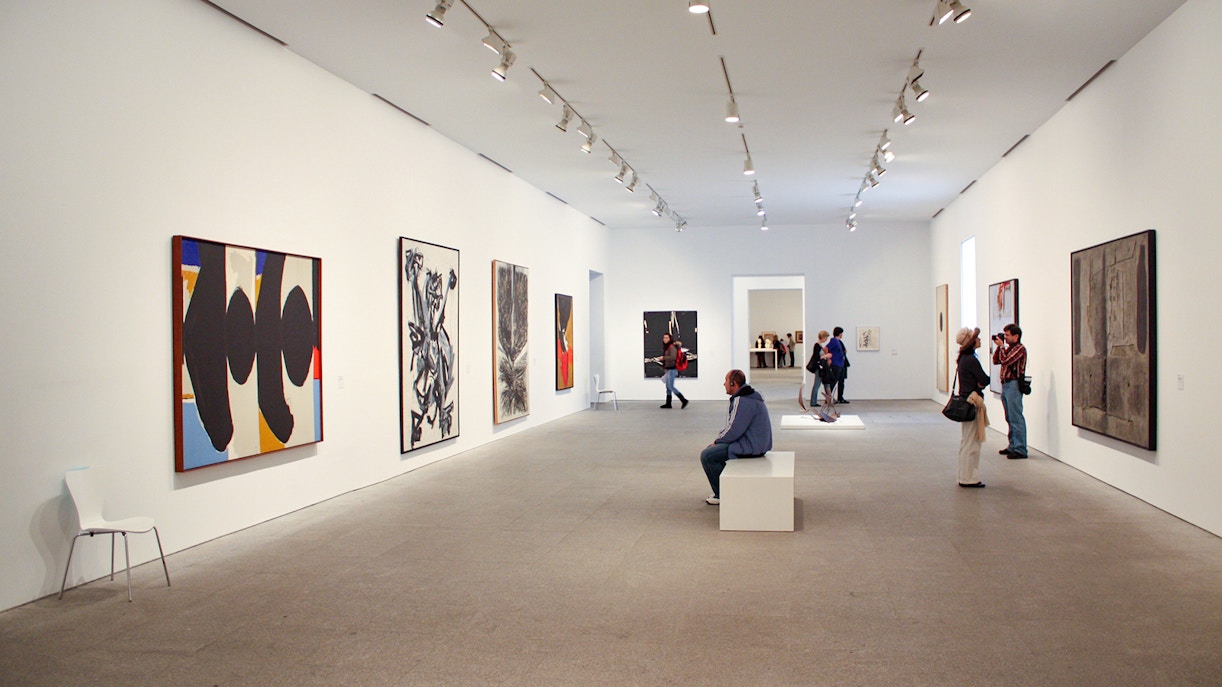
- Iconic Masterpieces: Encounter renowned works by legendary artists like Pablo Picasso and Salvador Dalí.
- Architectural Marvel: Marvel at the stunning architecture of the museum, including the iconic glass elevator and airy atrium.
- Modern Art Showcase: Immerse yourself in a diverse collection highlighting the evolution of 20th-century art.
- Library and Research Center: Delve into extensive resources at the museum's library and research center, catering to scholars and art enthusiasts.
- Educational Programs: Engage in educational programs, workshops, and events designed to deepen your understanding of art.
Which Reina Sofia Museum ticket is best for you?
Free Reina Sofia Museum Tickets
With valid ID, some individuals are allowed free access to Reina Sofia Museum. This includes people of age groups under 18 and over 65, UG & PG Students of Fine Arts, Conservation and Restoration, History and History of Art, Youth Card Holders, Transport Pass of the Community of Madrid Holders, People with disabilities & the family accompanying them, Resolution authorized cultural group members, Official Tourism Guides and Journalists.
Reina Sofia Museum highlights
Guernica by Pablo Picasso
Plan your visit to Reina Sofia Museum
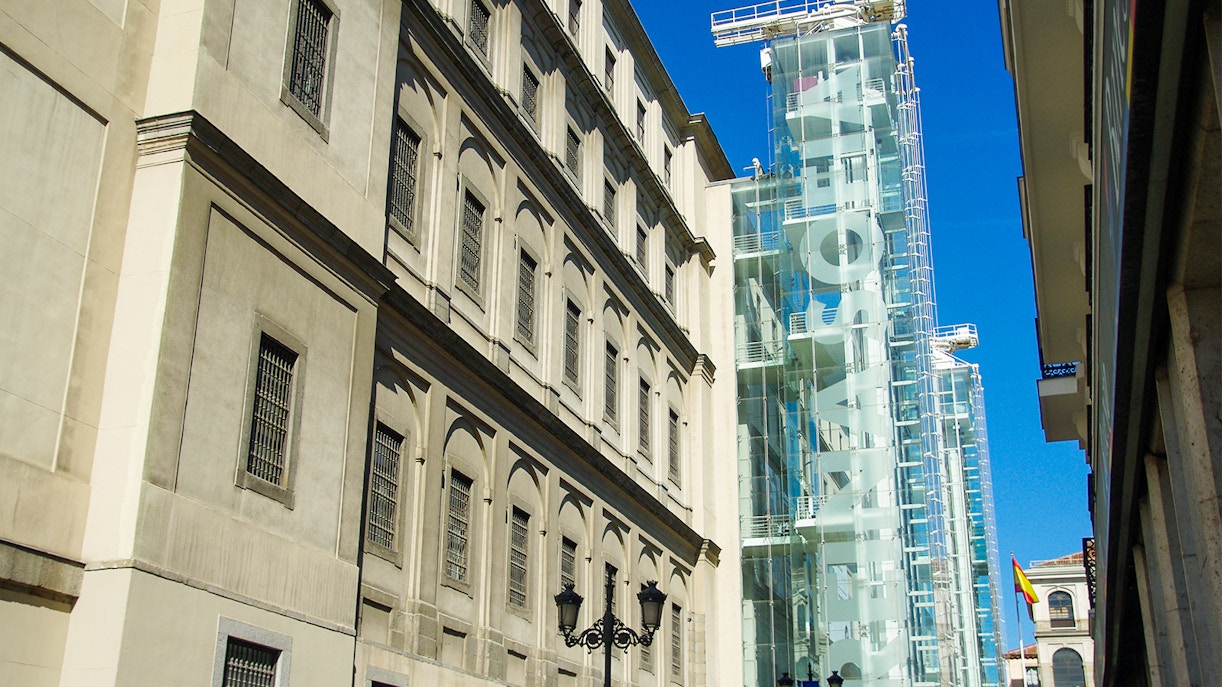
- The Main Venue Sabatini and Nouvel Building: 10 AM to 2:30 PM (except on Tuesday & Sunday)
Museum Opening Timings On Sunday: 10am to 2:30pm - Parque del Retiro, Palacio de Velázquez and Palacio de Cristal timings:
January - February: 10am - 6pm
March: 10am - 7pm
April - September: 11am - 10pm
October: 10am - 7pm
November - December: 10am - 6pm
It is open every day of the week though the timings change throughout the year. - Free entry: Mon, Wed, Thu, Fri, and Sat from 7am, Sun from 12:30pm, 18 April, 18 May, 12 October & 6 December
- Closed On: January 1st & 6, May 1st, May 15th, November 9th, & December 24th, 25th, and 31st.
Address: C. de Sta. Isabel, 52, 28012 Madrid, Spain
By Bus: EMT Line Bus
By Train: Nearest Train Station: Atocha-RENFE Train Station
By Metro: Line 1 Estación del Arte & Line 3 Lavapiés
By Bicycle: Nearest Bicycle Racks: At the Plaza Nouvel entrance, Sides of the Sabatini Building entrance
Parking facilities are available at: Atocha Train Station and Plaza Juan Goytisolo

- Lift facility available in the Nouvel and Sabatini Building with braille marking.
- Wi-Fi facility available.
- Locker/cloakroom available
- Bookshop
- Baby Changing Station
- Wheelchair accessible
- Accessible to individuals with disabilities.
- Accessibility education programs and activities for people with learning, visual, and hearing disabilities
- Emergency medical services are accessible at the museum for any unforeseen health incidents.

- The Reina Sofia Museum is free to visit on Wednesdays to Mondays from 6:00 PM to 8:00 PM, and Sundays from 1:30 - 2:15 p.m.
- It is important to note this, the exhibition rooms must be maintained at a temperature of 21º Celsius due to conservation measures. So, visitors are recommended to wear warm clothing.
- An adult must accompany those under the age of 14 years. Visitors aged 14-18 years need to carry ID and their Reina Sofia Museum Tickets.
- The Reina Sofia Museum is completely wheelchair accessible.
- Lifts in the Nouvel Building and Sabatini Building have a visual numbering scheme and even have braille for the visually disabled.
- The Palacio de Cristal will be closed on rainy or heat-wave days.
- All visitors are required to clear the gallery 15 minutes before closing time.
- Photography is allowed without the use of a flash, tripod, selfie stick, or any other type of camera stand.
- Due to the massive size of the Museum, it’s easy to get lost. So, please do keep track of the room numbers.

Arzábal: Arzábal seamlessly blends a bar concept with top-tier restaurant standards, offering meticulously crafted cuisine in a vibrant ambiance. Don't miss their signature alcachofas confitadas con jamón (confit artichokes with ham) or the delectable tarta de atún (tuna tartar).
Timings: The restaurant is open daily, from 11 am to 11 pm (Monday to Saturday) and 11 am to 8 pm on Sundays.
Café Restaurant NuBel: Chef Olmos curates a menu spotlighting simplicity and top-tier ingredients. Indulge in international breakfasts, daily brunches, and an array of dishes from egg specialties to pancakes, all accompanied by an assortment of teas and coffees. Set in a laid-back ambiance, Nubel provides a unique dining space that perfectly complements the museum experience.
Timings: Open from 9 am to 12 am on Mondays, Wednesdays, and Thursdays. On Fridays and Saturdays from 9am to 2am. Sundays from 9am to 6pm and it is closed on Tuesdays.

Royal Palace of Madrid: The Royal Palace of Madrid is, of course, the official residence of the Spanish royal family. It is also extremely close to the Reina Sofia Museum. However, the Palace is now used only for ceremonial purposes.
Royal Collections Gallery: Housing an unparalleled array of artistic masterpieces spanning centuries, this gallery showcases the opulence and grandeur of the Spanish monarchy. From exquisite paintings by iconic artists to regal tapestries and intricate artifacts, each piece is a testament to the enduring legacy of Spanish royalty.
Beyond the Reina Sofia Museum

Museo Nacional del Prado
Prado Museum, Madrid's art gem, boasts a rich collection of European masterpieces. Home to iconic works by Goya, Velázquez, and Titian, it epitomizes Spain's cultural heritage.
Explore Museo Nacional del Prado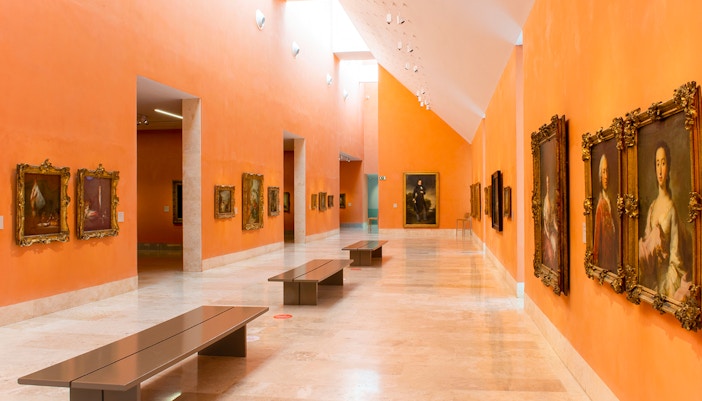
Thyssen-Bornemisza Museum
The Thyssen-Bornemisza National Museum is an art museum which exhibits an impressive private collection spanning seven centuries of European art. Along with the Museo Nacional del Prado It is known as part of the "Golden Triangle of Art”.
Explore Thyssen-Bornemisza Museum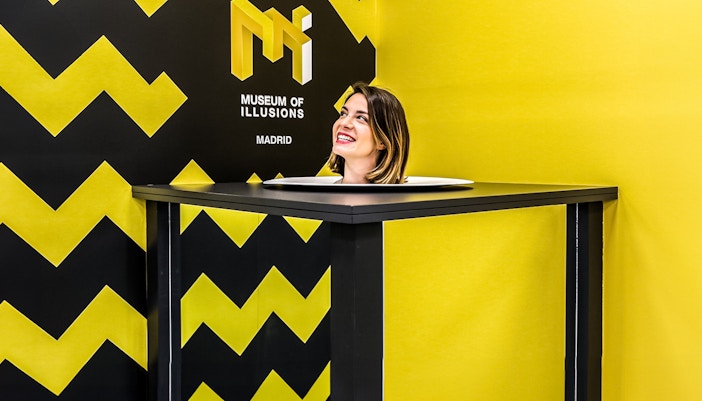
Museum of Illusions
The Museum of Illusions in Madrid is a place where you can see things that will mess with your mind! They have special rooms with pictures and designs that trick your eyes, make people look giant or tiny, and more!
Visit Museum of IllusionsFrequently asked questions about Reina Sofia Museum tickets
The Reina Sofia Museum is a renowned art museum in Madrid, specializing in contemporary and modern art. It houses an extensive collection of Spanish art, including masterpieces by artists such as Pablo Picasso and Salvador Dalí.
Yes, visitors can avail of discounts on Reina Sofia Museum tickets by purchasing them online. Discounts are available for individuals under 18 and over 65, UG & PG Students of Fine Arts, Conservation and Restoration, History and History of Art, Youth Card Holders, Transport Pass of the Community of Madrid Holders, People with disabilities & the family accompanying them, Resolution authorized cultural group members, Official Tourism Guides and Journalists.
Yes, you can buy tickets online and it is a much better option as it will allow you to book and plan ahead.
The best way to buy Reina Sofia Museum tickets would be to get them online. Not only can you choose from various kinds of tours, but you can also plan ahead.
The Reina Sofia Museum happens to be quite massive, and you can spend close to 4-5 hours without visiting all the exhibits. However, you can spend about a minimum of 2 hours to experience the main highlights and a few of the hidden gems.
The Reina Sofia Museum is open from Monday to Saturday, from 10:00 AM to 9:00 PM. On Sundays, it closes at 7:00 PM.
The Reina Sofia Museum is famous for housing Picasso's iconic painting "Guernica," a powerful anti-war masterpiece. Other highlights include works by Salvador Dalí, Joan Miró, and other influential Spanish and international artists.
The Reina Sofia Museum is committed to accessibility. It provides facilities such as ramps, elevators, and accessible restrooms.
The museum is centrally located in Madrid, making it easily accessible. It is situated near other major attractions like the Prado Museum and the Thyssen-Bornemisza Museum, allowing visitors to plan a convenient art tour.
While there is no strict route, the museum is designed to be explored chronologically. Many visitors start with the older collections and progress to more contemporary works. However, you are free to explore the museum in the order that interests you the most.
Yes, the Reina Sofia Museum often organizes educational programs, workshops, and activities for visitors of all ages. These programs aim to enhance the understanding and appreciation of art. Check the museum's website for information on scheduled events.

